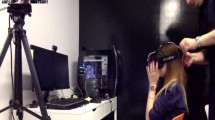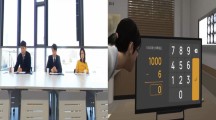Abstract
Response inhibition is a neurobehavioral construct important in understanding a range of various forms of psychopathology. Response inhibition is commonly assessed using paper-and-pencil behavioral measures and/or self-report questionnaires. Given that these assessment methods may be limited by a lack of ecological validity and retrospective recall biases, respectively, additional assessment methodologies are necessary. Virtual reality (VR) assessment may address some of the limitations of current assessment approaches in mental health. The purpose of this study was to therefore develop and preliminarily evaluate the validity of a VR-based measure of response inhibition and response inhibition under stress. Thirty-four participants completed the VR Task, as well as paper-and-pencil neurocognitive measures and self-report measures of attention and distress intolerance. Results suggest the VR Task performance converges with assessments of attention and response inhibition, and performance in the VR stressor condition is associated with perceived distress intolerance. These results, while highly preliminary, suggest that VR assessment of neurocognitive constructs relevant to mental health is feasible and a promising line of research.

Similar content being viewed by others
References
American Psychiatric Association. (2013). Diagnostic and statistical manual of mental disorders (5th ed.). Washington, DC: Author.
Bannon, S., Gonsalvez, C. J., Croft, R. J., & Boyce, P. M. (2002). Response inhibition deficits in obsessive–compulsive disorder. Psychiatry Research, 110(2), 165–174.
Bell-McGinty, S., Podell, K., Franzen, M., Baird, A. D., Williams, M. J. (2002). Standard measures of executive function in predicting instrumental activities of daily living in older adults. International Journal of Geriatric Psychiatry 17(9), 828-834.
Brown, T. A., & Barlow, D. H. (2009). A proposal for a dimensional classification system based on the shared features of the DSM-IV anxiety and mood disorders: implications for assessment and treatment. Psychological Assessment, 21(3), 256–271.
Carver, C. S., Johnson, S. L., & Timpano, K. R. (2017). Toward a functional view of the p factor in psychopathology. Clinical Psychological Science, 5(5), 880–889.
Derryberry, D., & Reed, M. A. (2002). Anxiety-related attentional biases and their regulation by attentional control. Journal of Abnormal Psychology, 111(2), 225–236.
Freeman, D., Reeve, S., Robinson, A., Ehlers, A., Clark, D., Spanlang, B., & Slater, M. (2017). Virtual reality in the assessment, understanding, and treatment of mental health disorders. Psychological Medicine, 47(14), 2393–2400.
Gohier, B., Ferracci, L., Surguladze, S. A., Lawrence, E., El Hage, W., Kefi, M. Z., ... & Le Gall, D. (2009). Cognitive inhibition and working memory in unipolar depression. Journal of Affective Disorders, 116(1–2), 100–105.
Golden, C. J., & Freshwater, S. M. (2002). Stroop Color and Word Test: a manual for clinical and experimental uses. Wood Dale: Stoetling Company.
Henry, M., Joyal, C. C., & Nolin, P. (2012). Development and initial assessment of a new paradigm for assessing cognitive and motor inhibition: the bimodal virtual-reality Stroop. Journal of Neuroscience Methods, 210(2), 125–131.
Insel, T., Cuthbert, B., Garvey, M., Heinssen, R., Pine, D. S., Quinn, K., ... & Wang, P. (2010). Research domain criteria (RDoC): toward a new classification framework for research on mental disorders. The American Journal of Psychiatry, 167(7), 748–751.
Krueger, R. F., & Markon, K. E. (2014). The role of the DSM-5 personality trait model in moving toward a quantitative and empirically based approach to classifying personality and psychopathology. Annual Review of Clinical Psychology, 10, 477–501.
Lalonde, G., Henry, M., Drouin-Germain, A., Nolin, P., & Beauchamp, M. H. (2013). Assessment of executive function in adolescence: a comparison of traditional and virtual reality tools. Journal of Neuroscience Methods, 219(1), 76–82.
Lezak, M. D., Howieson, D. B., Loring, D. W., & Fischer, J. S. (2004). Neuropsychological assessment (4th Ed.). New York, NY: Oxford University Press.
MacLeod, C. M. (1991). Half a century of research on the Stroop effect: an integrative review. Psychological Bulletin, 109(2), 163–203.
Miller, E. K., & Cohen, J. D. (2001). An integrative theory of prefrontal cortex function. Annual Review of Neuroscience, 24(1), 167–202.
Nelson, L. D., Strickland, C., Krueger, R. F., Arbisi, P. A., & Patrick, C. J. (2016). Neurobehavioral traits as transdiagnostic predictors of clinical problems. Assessment, 23(1), 75–85.
Parsons, T. D. (2015). Virtual reality for enhanced ecological validity and experimental control in the clinical, affective and social neurosciences. Frontiers in Human Neuroscience, 9, 660.
Parsons, T. D., Courtney, C. G., Arizmendi, B. J., & Dawson, M. E. (2011). Virtual reality Stroop task for neurocognitive assessment. In J. D. Westwood et al. (Eds.), Medicine meets Virtual Reality (pp. 433–439). Amsterdam: IOS Press.
Parsons, T. D., Courtney, C. G., & Dawson, M. E. (2013). Virtual reality Stroop task for assessment of supervisory attentional processing. Journal of Clinical and Experimental Neuropsychology, 35(8), 812–826.
Pierce, J. S., Pausch, R., Sturgill, C. B., & Christiansen, K. D. (1999). Designing a successful HMD-based experience. Presence, 8(4), 469–473.
Quigley, L., Wright, C. A., Dobson, K. S., & Sears, C. R. (2017). Measuring attentional control ability or beliefs? Evaluation of the factor structure and convergent validity of the attentional control scale. Journal of Psychopathology and Behavioral Assessment, 39(4), 742–754.
Reinholdt-Dunne, M. L., Mogg, K., & Bradley, B. P. (2009). Effects of anxiety and attention control on processing pictorial and linguistic emotional information. Behaviour Research and Therapy, 47(5), 410–417.
Reitan, R. M., & Wolfson, D. (1985). The Halstead–Reitan neuropsychological test battery: therapy and clinical interpretation. Tucson: Neuropsychological Press.
Simons, J. S., & Gaher, R. M. (2005). The distress tolerance scale: development and validation of a self-report measure. Motivation and Emotion, 29, 83–102.
Vujanovic, A. A., Bonn-Miller, M. O., Potter, C. M., Marshall, E. C., & Zvolensky, M. J. (2011). An evaluation of the relation between distress tolerance and posttraumatic stress within a trauma-exposed sample. Journal of Psychopathology and Behavioral Assessment, 33(1), 129–135.
Watson, D., & Clark, L. A. (1988). Development and validation of brief measure of positive and negative affect: the PANAS scale. Journal of Personality and Social Psychology, 54(6), 1063–1070.
Rizzo, A. A., Schultheis, M., Kerns, K. A., Mateer, C. (2004). Analysis of assets for virtual reality applications in neuropsychology. Neuropsychological Rehabilitation 14(1-2), 207-239.
Acknowledgments
The authors would like to express our gratitude to Stephen Shaul and Kelsey Griffin for their assistance in the development of the VR simulation and running study sessions.
Author information
Authors and Affiliations
Corresponding author
Ethics declarations
Prior to initiation of this study, approval was obtained by the University of Baltimore Institutional Review Board (IRB). All participants acknowledged written informed consent before study participation.
Additional information
Publisher’s Note
Springer Nature remains neutral with regard to jurisdictional claims in published maps and institutional affiliations.
Rights and permissions
About this article
Cite this article
Donahue, J.J., Shrestha, S. Development and Preliminary Validation of a Virtual Reality–Based Measure of Response Inhibition Under Normal and Stressful Conditions. J. technol. behav. sci. 4, 219–226 (2019). https://doi.org/10.1007/s41347-018-0084-0
Published:
Issue Date:
DOI: https://doi.org/10.1007/s41347-018-0084-0




